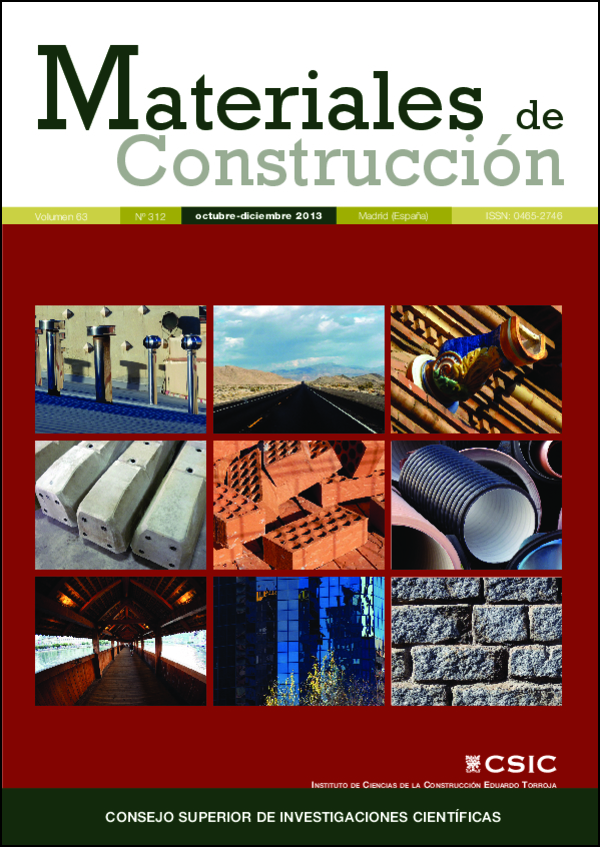Correction factors to predict the in-place compressive strength of a self-compacting concrete
DOI:
https://doi.org/10.3989/mc.2013.04512Keywords:
self-consolidating concrete, in-place compressive strength, core samples, cylindrical specimens, cubic specimensAbstract
The present study aimed to determine whether certain correction factors used in the in-place prediction of compressive strength with concrete cores are directly applicable to self-consolidating concretes (SCCs). The parameters considered were core diameter, casting direction, core moisture, a number of variables intrinsic to cores, and concrete strength. Factors were also established for converting SCC 15 3 15-cm cubic specimen strength into 30 315-cm cylindrical specimen strength. The findings show that the correction factors recommended in EHE-08 and ACI 214.4R-10 overestimate the in-place compressive strength of the SCC analysed. The factors found for converting cubic into cylindrical specimen strength, in turn, were observed to differ from the values set out in the 2010 Model Code, but to be similar to the EHE-08 code proposals.
Downloads
References
(1) American Concrete Institute. ACI 214.4R. Guide for obtaining cores and interpreting compressive strength results, 2010.
(2) Comisión Permanente Hormigón. EHE-08: Instrucción de hormigón estructural. Ministerio de Fomento. Madrid, 2008.
(3) Pérez, M.: “Relación entre la resistencia a compresión de probetas testigo y probetas normalizadas”, Mater .Construcc., 48 (249), 45-53 (1998). http://dx.doi.org/10.3989/mc.1998.v48.i249.486
(4) Yi, S.T.; Yang, E. I.; Choi, J. C.: “Effect of specimen sizes, specimen shapes, and placement directions on compressive strength of concrete”, Nuclear Engineering and Design, 2006. 236(2), 115-127. http://dx.doi.org/10.1016/j.nucengdes.2005.08.004
(5) Domone, P. L.: “A review of the hardened mechanical properties of self-compacting concrete”. Cement & Concr. Comp. 29, 2007, 1–12. http://dx.doi.org/10.1016/j.cemconcomp.2006.07.010
(6) AENOR. UNE-EN 12390-3: Ensayos de hormigón endurecido. Parte 3: Determinación de la resistencia a compresión de probetas. Madrid, 2009.
(7) Rojas, L.: “Ensayos de información y extracción de probetas testigo en hormigones autocompactantes”. Tesis doctoral. E.T.S.I de Caminos, Canales y Puertos. Universidad Politécnica de Madrid, 2012.
(8) Rojas, L.; Fernández, J.; López, J.C.: “Rebound Hammer, Pulse Velocity, and Core Tests in Self-Consolidating Concrete”, ACI Materials Journal 109 (2) (Mar/Apr 2012), 235-243.
(9) ACHE, Asociación Científico-Técnica del Hormigón Estructural. Grupo de trabajo 2/4. Monografía M-19: Modelos lineales aplicados al hormigón estructural. Madrid, 2012.
(10) Mansur, M. A.; Islam, M. M.: Interpretation of concrete strength for nonstandard specimens. Journal of Materials in Civil Engineering, 2002. 14(151).
(11) CEB-FIP, Model Code: Comite Euro-International du Béton. Bulletin d’Information Nº 213/214. Ed. Thomas Telford, London, 2010.
Downloads
Published
How to Cite
Issue
Section
License
Copyright (c) 2013 Consejo Superior de Investigaciones Científicas (CSIC)

This work is licensed under a Creative Commons Attribution 4.0 International License.
© CSIC. Manuscripts published in both the print and online versions of this journal are the property of the Consejo Superior de Investigaciones Científicas, and quoting this source is a requirement for any partial or full reproduction.
All contents of this electronic edition, except where otherwise noted, are distributed under a Creative Commons Attribution 4.0 International (CC BY 4.0) licence. You may read the basic information and the legal text of the licence. The indication of the CC BY 4.0 licence must be expressly stated in this way when necessary.
Self-archiving in repositories, personal webpages or similar, of any version other than the final version of the work produced by the publisher, is not allowed.
















